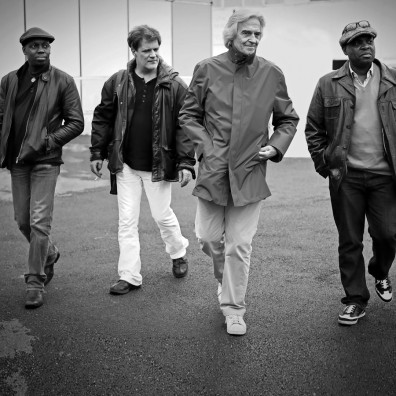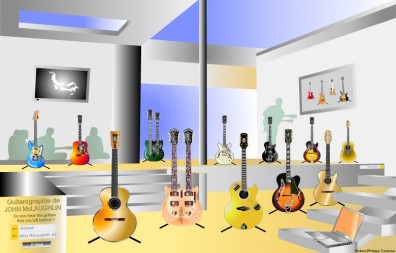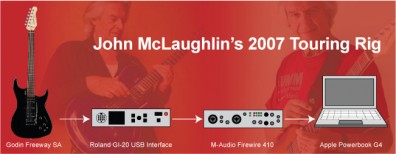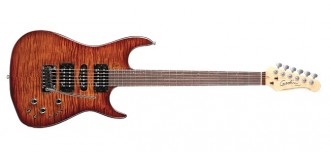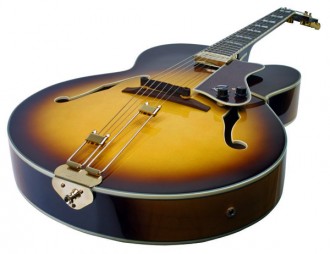John McLaughlin Remembers
At the back end of the 80s I decided I would update my ageing audio gear and commenced a search for the best for my budget. I bought every review magazine going including Hi-Fi Choice which also happened to feature the magazine’s choice of the best 50 CD recordings. So as soon as I settled on my new hi-fi kit I launched into acquiring all 50 albums in quick time to see just how much better my equipment was. One of the albums in this truly great selection was John McLaughlin, Al DiMeola and Paco De Lucia’s live concert SATURDAY NIGHT IN SAN FRANCISCO. My love affair with the work of John McLaughlin began, and on going through my music collection recently realised that he represented the largest number of recordings (CD and Vinyl) by any single artist on my shelves. I even possess a record (Belo Horizonte) signed by him and gifted to a Dr E. Eugene Watson on which he wrote, “To Gene with best wishes and appreciation for your input into the improvement of the guiitar” signed John McLaughlin. For me, he is the world’s finest and most innovative guitarist and composer, of all time. During the research for my Ravi Shankar piece I found out that McLaughlin had been taught to play the Sitar by Shankar. I began to research McLaughlin after I completed the Ravi Shankar story, and found similarities in both artists. Much of what is here is written by McLaughlin and reveals a man on a never-ending personal journey of musical, religious and philosophical discovery, and work with many of the world’s greatest instrumentalists.
As McLaughlin approaches his 70th birthday, I offer this as a sincere tribute to a musician who has inspired me to ‘look beyond.’
What of John McLaughlin’s actual guitar playing? Pat Metheny says McLaughlin has changed the evolution of the guitar at least three times, making him “one of the most significant figures in the modern history of the guitar.” What of his jazz compositions? They are now being treated with the reverence of classical music pieces and being interpreted the world over by jazz, rock and classical musicians.
I’m going to start this fascinating story with his tools…
McLaughlin’s Guitars
From top left to right.
Fender Mustang, Gibson Hummingbird, Gibson Double-Neck, ‘72 Gibson ES-345, Gibson Les Paul Custom, Gibson L4, Ovation Custom Legend, Abraham Wechter Our Lady (Notre Dame), Rex Bogue Double Rainbow, Abraham Wechter Shakti #2, Gibson Johnny Smith, Abraham Wechter Marielle.
With his latest band, 4th Dimension, he tours with the following rig:
His performance guitar is the Godin Freeway SA with the following specifications:
Neck: Rock Maple
Fingerboard: Rosewood w/ Radius 12”
Body: Silverleaf Maple center w/ Poplar wings
Nut: Tusq
Scale: 25 ½”
Bridge: floating trem equipped with Ghost saddle pickups and the Hexpander Modular Pre-amp
Frets: 22 medium jumbo
Pickups: Neck: Godin GHN1
Middle: Godin GS1
Bridge: Godin GHB1
Controls: 5-way pickup switch, volume and tone
Controls for the Ghost system: Momentary mini toggle serves multiple functions on a GR-Series guitar synth 3-Way mini toggle selects between synth, guitar or both Volume for synth.
Here is the content of a letter written by McLaughlin about his equipment and sent to a jazz magazine:
Here is a breakdown of the equipment I’ve been using over the last decade or so.
In the early 1990s, I was playing acoustic guitar exclusively. My instrument of choice was a handmade Wechter with a Florentine cutaway. The amplification I used was a Fishman Blender System. This system was comprised of a “classical” transducer (about 1mm thick) stuck underneath the bridge area inside the guitar, and a condenser microphone that Larry Fishman developed exclusively for acoustic guitar. This mic was positioned in the soundhole using a special brace that Larry devised. All in all, this gave me a good acoustic sound, which was lightly reinforced by judicious use of the transducer. Larry also designed an acoustic bridge that employed individual piezo pickups for each string. Although this is fairly common these days, it was something special at the time. This system allowed me to use the Photon MIDI guitar system in conjunction with the acoustic guitar. The Photon has not been manufactured for quite a few years now. My use of this setup can be heard on recordings such as Live at the Royal Festival Hall, and Que Alegria.
By the mid 90s I was playing the electric guitar again, only this time I used either the Gibson Johnny Smith archtop guitar with a Bigsby tailpiece (custom installed), or a Gibson L4 with a Charlie Christian pickup (also with a Bigsby). By this time I’d given up on amps, and was using a Sony M7 preamp/effects unit (no longer manufactured), which is an extremely powerful unit in the sense that one can really fine tune the tone of the guitar with the different parametric equalizers available, in conjunction with a number of different chorus effects and delays. I patched directly from this unit into the house sound system. For the Heart of Things band, I was using two SonyM7s. One of them was set on a ring modulator, which I was able to bring in and out by using a MIDI foot controller. The sound was then passed through a distortion unit (using very light distortion), and overall I was very satisfied with the result. This setup can be heard on Live in Paris.
By 1998 I was again touring with Remember Shakti. My setup consisted of a1970s Gibson 345 with a scalloped fingerboard, a modification made around 1977. In 1997 I had had more modifications made: the installation of the pickup from the Johnny Smith, plus a Bigsby tailpiece. I toured for the next five years with this instrument.
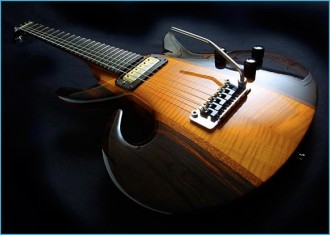
In the spring of 2002, I began recording a piece for orchestra and acoustic guitar called Thieves & Poets, which also had four standards arranged for six acoustic guitars, (five guitars + acoustic bass). For this recording I used the last guitar that Abraham Wechter built for me, which is known as “Our Lady,” or “Notre Dame” on account of the design of the interior of the Rosace.
I began work on my instructional DVD for guitar improvisation in April 2003, and it will soon be completed. I needed to be able to record audio and MIDI simultaneously. MIDI was needed for the score notation, which is in sync with the audio. For both of these purposes, I found the Godin LGXT to be excellent, and I recorded the entire program (three DVDs!) with this instrument. I subsequently discovered that Richard McClish of RMC pickups in Berkeley was the guiding light behind this technology. I was so impressed that I played a three month tour with Remember Shakti using this instrument to great effect with another wonderful piece of equipment .
I’m a faithful Macintosh computer user, and in the spring of 2003 I bought a G4 laptop. With the kind support of Logic Audio and the inspired help of my engineer Marcus Wippersberg, we were able to successfully emulate the sound I obtained from the Sony M7 (at least five units were trashed by airlines!). The combination of Logic Audio, which is such a great program, and the unbelieveable power of the G4 allowed me to record MIDI synth and audio simultaneously to great effect. For the moment this setup has only been used in concert, but will be recorded soon.
I hope you’ll find this information useful .
Best Wishes,
John
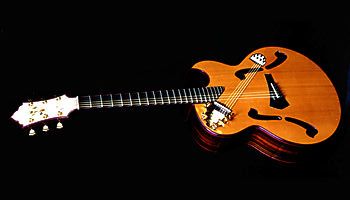 The Original Abraham Wechter Shakti #2 Guitar
The Original Abraham Wechter Shakti #2 Guitar
The idea for the Shakti Guitar struck McLaughlin early 1971 after he started learning Veena, a South-Indian stringed musical instrument, under Dr. S. Ramanathan, then a teacher of South Indian music at the University of Connecticut. When McLaughlin formed the fusion band Shakti with Zakir Hussain, L. Shankar and Vikku Vinayakram, he started looking for a Veena-like articulation in his guitar which led him to Abraham Wechter, a consulting luthier for Gibson guitars. In collaboration with the Gibson R&D team and helped by the ideas from the Sarod (a North-Indian stringed musical instrument) maestro Ustad Ali Akbar Khan, McLaughlin took his first Shakti guitar to stage for the Shakti concerts in the 1975-1976 timeframe.
Coming to what a Shakti guitar is all about, it mainly differs from the normal guitar in terms of its 13 strings, made up of seven drone strings in addition to the standard six. The seven sympathetic drone strings are placed beneath and diagonal to the standard ones. Another innovation was the scalloped fingerboard, ie, the area between the frets were shaped concavely similar to that of a Veena. This ensured that the fingertips didn’t touch the fretboard while playing, and also enabled pushing down.
The scalloped fingerboard of a Veena and pulling of strings across frets. What resulted from all this was a radically new sound that had never before been heard from a guitar.
The Shakti guitar was used extensively by McLaughlin during his Shakti concerts till late 1970s. In 1978 however the band got broken due to various reasons, and that unfortunately was the last that was seen of the Shakti guitar. In 1997 when the band was reincarnated as Remember Shakti, he could not use the Shakti guitar as it had been previously lent to a musician and was returned in a totally unusable condition. McLaughlin instead went for Gibson Johnny Smith, a hollow bodied acoustic-electric guitar that he had been playing in between. The Shakti guitar was not seen to return even in the subsequent concerts of Remember Shakti, the last one being in 2007. Here is hoping that John McLaughlin decides to use the great instrument in the near future so that the current generation gets to see it live in action.
|
|
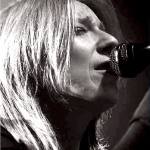
|
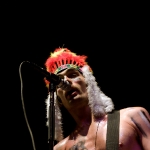
The All-American Rejects |
LATEST GALLERY IMAGES

The Price of Food 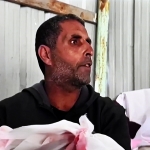
The Invisible Enemy |
|
|


